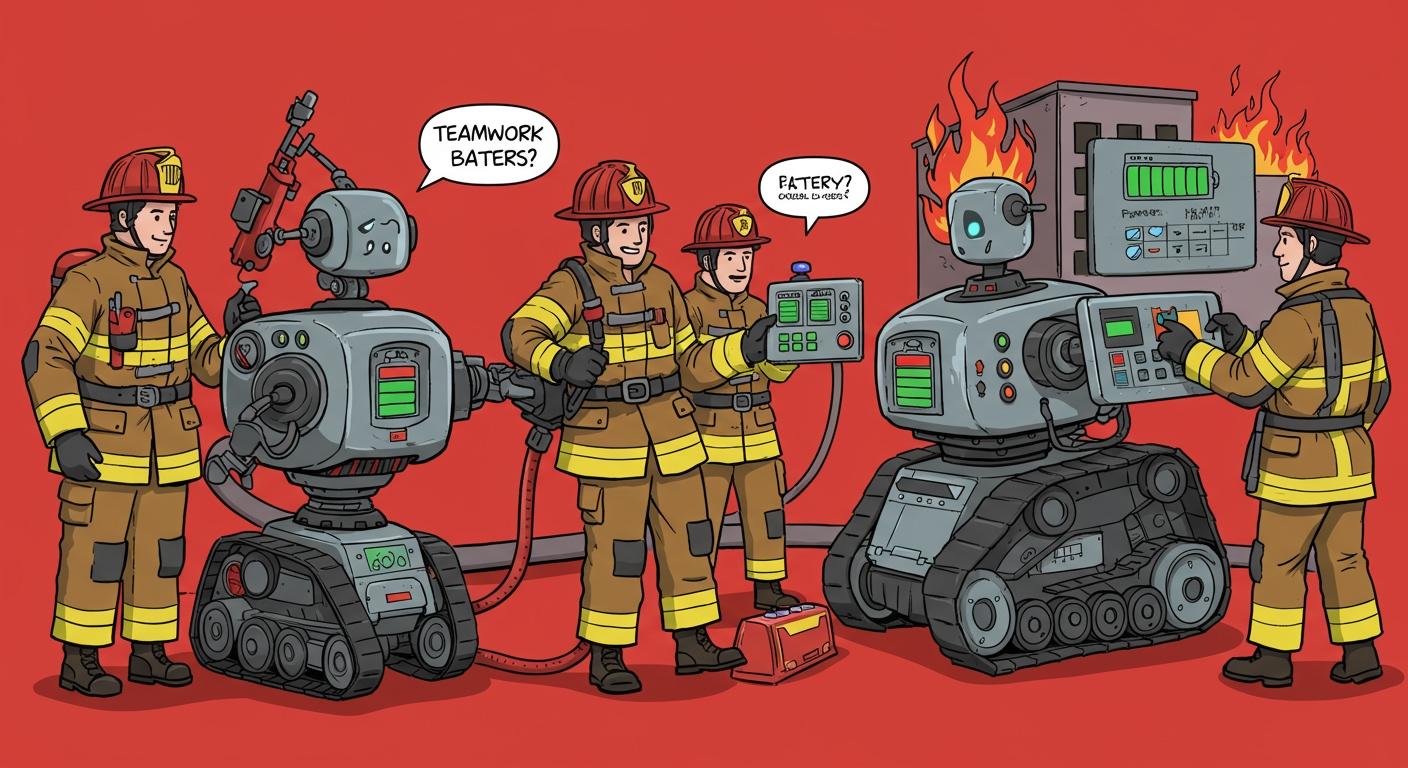
You rely on battery technology to keep firefighting robots operating in hazardous zones where traditional fire prevention methods cannot reach. High-temperature resistant battery systems allow robots to tackle fire and toxic smoke, protecting firefighters from direct danger. Recent incidents, such as electric vehicle fires and explosions in parking garages, show why innovation in battery safety matters for emergency response. As the market for firefighting robots expands worldwide, you see prevention and technology working together to enhance fire safety and mission success.
Key Takeaways
Firefighting robots reduce risks for firefighters by entering hazardous environments, allowing for safer operations and quicker response times.
High-temperature resistant battery systems are crucial for firefighting robots, ensuring they operate effectively in extreme heat and hazardous conditions.
Battery management systems enhance safety by monitoring battery performance, preventing overheating, and ensuring reliable operation during emergencies.
Choosing the right lithium battery chemistry, like LiFePO4 or solid-state, can significantly improve the lifespan and safety of firefighting robots.
Ongoing training and education on battery safety are essential for firefighters to effectively manage risks and enhance operational success.
Part 1: Firefighting Robots and Safety

1.1 Reducing Risk for Firefighters
You face many dangers when entering a burning building or hazardous site. Firefighting robots help you minimize these risks by taking on the most dangerous tasks. These robots can enter environments filled with toxic fumes, extreme heat, or unstable structures. You can deploy them in places where explosions or chemical spills make human entry unsafe. By using search and rescue robots, you reduce the chance of injury or fatality for your team.
Firefighting robots can:
Enter burning buildings, chemical plants, or forest fires, keeping you out of harm’s way.
Handle situations with toxic fumes or the risk of explosions.
Respond immediately, without waiting for human assessment.
Work continuously, improving response times and efficiency.
You see the benefits in real time. Robotics integration can improve response times by about 15%. Advanced sensors and autonomy allow robots to locate and suppress fire, reducing your exposure to danger. Unmanned aerial vehicles and fully automatic fire fighting robots can reach hard-to-access areas, making rescue operations safer and more effective.
1.2 Reliability in Emergency Operations
Reliability is essential for your emergency response. When you trust robots to support fire suppression or rescue, you need them to perform under pressure. However, firefighting robots face several reliability challenges:
Reliability Issue | Description |
|---|---|
Thermal Imaging Limitations | Extreme heat can affect the accuracy of thermal imaging, complicating decision-making in fires. |
Navigation Challenges | Robots struggle with mapping and traversing complex, smoke-filled, and debris-laden environments. |
Real-time Decision-making Difficulties | The unpredictable nature of fire environments poses challenges for robots in making timely decisions. |
You must integrate remote control fire fighting robots and autonomous robots into your emergency response plans. This integration can be complex and may require specialized training. Environmental conditions, such as high temperatures and thick smoke, can affect robot performance. Still, the intelligence and adaptability of these systems continue to improve. When you rely on robots, you enhance safety outcomes for firefighters and increase the success rate of rescue missions.
Part 2: Battery Technology for Firefighting Robots

2.1 High-Temperature Resistance
You depend on battery technology that can withstand extreme heat during fire emergencies. Firefighting robots often operate in hazardous environments where temperatures can rise rapidly. Lithium battery packs must maintain durability and safety even when exposed to intense heat.
Power optimization helps you ensure even charging and discharging of battery cells.
Thermal regulation prevents overheating in high-temperature zones.
Safety management detects faults before failures occur.
Real-time monitoring provides live battery status and predicts runtime.
Balancing power draw prevents voltage drops that could destabilize robotic firefighting technologies.
Adaptive thermal management adjusts charging rates based on temperature.
Fail-safe protocols initiate controlled shutdowns if critical battery thresholds are reached.
You see that rapid temperature escalation during fire events can exceed 1,000°F (538°C) in seconds. Most lithium-ion batteries, such as LiFePO4 (LFP) and NMC, have specific limits. LFP batteries typically experience thermal runaway around 195°C, while NMC batteries reach this point at approximately 180°C. The general operational temperature range for lithium-ion batteries is between 60°C and 100°C.
Tip: Always select battery technology with proven high-temperature resistance for fire technology applications.
Technical Comparison of Lithium Battery Chemistries
Chemistry | Thermal Runaway Temp | Operational Temp Range | Safety Profile | Typical Use in Firefighting Robots |
|---|---|---|---|---|
LiFePO4 (LFP) | ~195°C | 60–100°C | High | Common |
NMC | ~180°C | 60–100°C | Moderate | Common |
LCO | ~150°C | 60–80°C | Moderate | Limited |
LMO | ~250°C | 60–100°C | High | Specialized |
LTO | ~300°C | 60–100°C | Very High | Specialized |
Solid-State | >300°C | 60–120°C | Very High | Emerging |
Lithium Metal | >300°C | 60–120°C | Very High | Experimental |
2.2 Lithium-Ion Safety Features
You must address lithium-ion safety concerns to prevent fire and explosion risks in hazardous scenarios. Modern lithium battery packs for firefighting robots include advanced safety features that protect both the robot and the operator.
Safety Feature | Description |
|---|---|
Improved Battery Pack Design | Minimizes excessive heat buildup and thermal propagation through proper spacing and thermal insulation. |
Thermal Barriers | Slows down heat transfer using materials like ceramic coatings and aerogels. |
Passive Cooling | Allows natural air circulation to prevent localized overheating. |
Active Cooling Systems | Uses liquid or air cooling to maintain stable temperatures during high-power operations. |
Monitors voltage, current, and temperature to prevent conditions leading to thermal runaway. | |
Safer Battery Chemistries | Lithium Iron Phosphate (LFP) batteries are less likely to undergo thermal runaway compared to NMC/NCA. |
Solid-State Batteries | Non-flammable and highly resistant to overheating, potentially eliminating thermal runaway. |
Recent advancements in lithium-ion battery safety help you manage risks during fire emergencies. You can establish safety zones to protect from potential hazards. Cooling techniques help you control heat generated by lithium-ion batteries. You benefit from collaboration with EV manufacturers to improve firefighting technology and techniques. Regular training programs and emergency shutdown procedures keep you prepared for hazardous situations.
2.3 Battery Management Systems
You rely on battery management systems (BMS) to monitor and control battery safety in robotic firefighting technologies. BMS technology plays a critical role in maintaining operational safety and performance.
Feature | Description |
|---|---|
Continuous Cell Balancing | Balances cells during operation to minimize downtime and maintain efficiency. |
Self-Diagnostics | Runs tests to ensure proper functioning of BMS modules, identifying issues like damaged connections. |
Temperature Monitoring | Detects temperature increases and activates cooling systems to prevent overheating. |
Dynamic Current Limits | Adjusts current thresholds to prevent over-temperature, over-charging, and over-discharging. |
You use sensors to track battery status in real time. These sensors help you predict flight time and prevent voltage drops that could destabilize robots during fire emergencies.
Note: Battery management systems are essential for maintaining safety and reliability in firefighting robots.
Part 3: Operational Demands in Emergency Firefighting
3.1 Runtime and Lifespan
You rely on lithium battery packs to power advanced firefighting robots during critical fire emergencies. The runtime and lifespan of these batteries determine how long your robots can operate in hazardous zones. You need batteries that deliver consistent energy, even when exposed to extreme heat, smoke, or water. Sensors inside the battery packs monitor temperature and voltage, helping you avoid sudden shutdowns during rescue missions.
Long-lasting batteries support extended fire suppression and fire prevention activities. You see lithium chemistries like LiFePO4 and NMC used in robotic firefighting technologies because they offer high energy density and thermal stability. Solid-state batteries provide even greater safety and lifespan, making them ideal for advanced firefighting technologies. You benefit from real-time battery monitoring, which allows you to track battery health and predict when maintenance is needed.
Here is a comparison of lithium battery applications across industries:
Industry | Typical Lithium Chemistry | Runtime Needs | Lifespan Requirements | Application Example |
|---|---|---|---|---|
Medical | LCO, NMC | Long | High | Portable ventilators |
Robotics | LiFePO4, NMC, LTO | Extended | High | Firefighting robots |
Security System | LiFePO4, LMO | Moderate | Moderate | Surveillance drones |
Infrastructure | NMC, LTO | Long | High | Traffic monitoring systems |
Consumer Electronics | LCO, NMC | Short | Moderate | Smartphones |
Industrial | LiFePO4, LTO | Extended | High | Remote control fire fighting robots |
Tip: Choose lithium battery packs with proven thermal stability and long cycle life for fire technology applications.
3.2 Rapid Deployment Needs
You must deploy firefighting robots quickly during emergencies. Battery technology advancements make rapid deployment possible. Reliable batteries allow robots to operate in hazardous environments without delay. You need quick charging capabilities to minimize downtime between missions. Sensors provide real-time data, helping you assess battery status before sending robots into fire zones.
Consider these factors that affect rapid deployment:
Limited battery life restricts operational time for firefighting robots.
Difficult terrain and stairwells challenge maneuverability.
Extreme heat, smoke, and water exposure impact robot performance.
High costs may limit widespread adoption of collaborative robot fire solutions.
Firefighting drones require batteries that support heavy payloads and frequent flight adjustments. High-capacity lithium-ion or lithium-polymer batteries offer the best energy density-to-weight ratio for extended missions. Redundant power systems and battery management systems help you maintain continuous operation, even if one battery fails. You see remote control fire fighting robots and drones using these technologies to improve response and prevention in hazardous scenarios.
Note: Reliable battery packs and sensors are essential for successful rescue and fire prevention operations.
Part 4: Advancements and Real-World Impact
4.1 Case Studies in Firefighting
You see reliable lithium battery packs making a difference in real-world firefighting scenarios. In a recent warehouse fire, robots equipped with LiFePO4 batteries operated for hours in high temperatures, allowing you to control the blaze without risking your team. These robots navigated debris and smoke, using advanced sensors and battery management systems to maintain performance. In another emergency, drones powered by NMC batteries provided aerial views, helping you coordinate rescue efforts and monitor fire spread. These examples show how innovation in battery technology protects firefighters and improves mission outcomes.
You benefit from ongoing research projects, such as those led by NIST, which assess fire risks linked to lithium-ion batteries. These projects help you understand fire behavior and chemical exposure, leading to safer firefighting strategies. You also gain insights from the International Association of Fire Chiefs, which develops training and tools for managing lithium-ion battery incidents. Collaboration with technology developers and industry experts strengthens your emergency response and keeps you prepared for new challenges.
Note: For more on sustainability and conflict minerals in battery production, visit Our Approach to Sustainability and Conflict Minerals Statement.
4.2 Future Trends in Battery Safety
You can expect several advancements in battery safety for firefighting robots. The following table highlights promising trends:
Trend Description | Impact on Battery Safety |
|---|---|
Intelligent Battery Management Systems (BMS) | Monitors real-time data to prevent thermal runaway, overcharge, and overdischarge. |
Adaptive Charging Rates | Regulates charging to avoid hazardous situations during operation. |
Structural Design of Battery Packs | Improves resistance to dust, shocks, and moisture for reliable use in harsh environments. |
Compliance with Safety Standards | Ensures prototypes meet rigorous safety regulations before mass production. |
Emerging battery technologies, such as solid-state and lithium metal chemistries, offer greater thermal stability and longer lifespans. You see these innovations reducing risks for firefighters by minimizing fire hazards and improving operational reliability. Training remains essential. You can access educational initiatives like the “Take C.H.A.R.G.E. of Battery Safety” campaign, online courses on fire safety, and specialized lithium-ion battery fire safety programs. These resources help you and your team stay informed and ready for any emergency.
Tip: Stay updated on battery safety education to protect your team and enhance firefighting effectiveness.
You see advanced lithium battery packs as the backbone of reliable firefighting robots. These systems help you face fire threats by supporting robots that withstand extreme heat and hazardous conditions. Ongoing innovation brings new features:
Robots use high-powered water jets or fire suppression foam for targeted response.
AI and autonomous navigation improve real-time decision-making during fire emergencies.
Industry standards like NFPA 855 and UL 9540A guide safe battery system deployment.
You benefit from partnerships that focus on safety, preplanning, and education. Workshops and public campaigns help you understand battery hazards and best practices. As battery technology evolves, you gain stronger tools for mission success and firefighter protection.
FAQ
What makes lithium battery packs suitable for firefighting robots?
Lithium battery packs, such as LiFePO4 and NMC, offer high energy density and thermal stability. You can rely on these chemistries to power robots in extreme heat, smoke, and hazardous conditions during firefighting operations.
How do battery management systems improve safety?
Battery management systems monitor voltage, temperature, and current. You use these systems to prevent overheating, overcharging, and sudden shutdowns. This technology helps you maintain safe and reliable robot performance.
Which lithium battery chemistry lasts longest in emergency robots?
You see solid-state and LTO batteries provide the longest lifespan and highest thermal stability. The table below compares cycle life and temperature resistance for common chemistries:
Chemistry | Cycle Life | Max Temp Resistance |
|---|---|---|
LiFePO4 | 2000+ | ~195°C |
NMC | 1000+ | ~180°C |
LTO | 7000+ | ~300°C |
Solid-State | 4000+ | >300°C |
Can you recharge lithium battery packs quickly during emergencies?
You can recharge lithium battery packs rapidly using advanced charging systems. Fast charging technology reduces downtime and supports continuous robot deployment in emergency situations.
What training do teams need for safe battery use in firefighting robots?
You need training on lithium battery safety, emergency shutdown procedures, and battery management system operation. Educational programs and online resources help you stay prepared for battery-related hazards.






